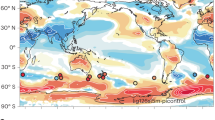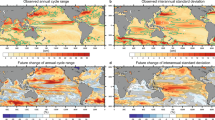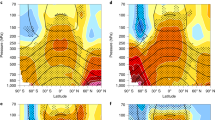Abstract
Determining the time when the climate change signal from increasing greenhouse gases exceeds and thus emerges from natural climate variability (referred to as the time of emergence, ToE) is an important climate change issue1. Previous ToE studies were mainly focused on atmospheric variables2,3,4,5,6,7. Here, based on three regional sea-level projection products available to 2100, which have increasing complexity in terms of included processes, we estimate the ToE for sea-level changes relative to the reference period 1986–2005. The dynamic sea level derived from ocean density and circulation changes alone leads to emergence over only limited regions. By adding the global-ocean thermal expansion effect, 50% of the ocean area will show emergence with rising sea level by the early-to-middle 2040s. Including additional contributions from land ice mass loss, land water storage change and glacial isostatic adjustment generally enhances the signal of regional sea-level rise (except in some regions with decreasing total sea levels), which leads to emergence over more than 50% of the ocean area by 2020. The ToE for total sea level is substantially earlier than that for surface air temperature and exhibits little dependence on the emission scenarios, which means that our society will face detectable sea-level change and its potential impacts earlier than surface air warming.
This is a preview of subscription content, access via your institution
Access options
Subscribe to this journal
Receive 12 print issues and online access
$209.00 per year
only $17.42 per issue
Buy this article
- Purchase on Springer Link
- Instant access to full article PDF
Prices may be subject to local taxes which are calculated during checkout




Similar content being viewed by others
References
Kirtman, B. et al. in Climate Change 2013: The Physical Science Basis (eds Stocker, T. F.et al.) 953–1028 (IPCC, Cambridge Univ. Press, 2013).
Diffenbaugh, N. S. & Scherer, M. Observational and model evidence of global emergence of permanent, unprecedented heat in the 20th and 21st centuries. Climatic Change 107, 615–624 (2011).
Mahlstein, I., Knutti, R., Solomon, S. & Portmann, R. W. Early onset of significant local warming in low latitude countries. Environ. Res. Lett. 6, 034009 (2011).
Hawkins, E. & Sutton, R. Time of emergence of climate signals. Geophys. Res. Lett. 39, L01702 (2012).
Mora, C. et al. The projected timing of climate departure from recent variability. Nature 502, 183–187 (2013).
Mahlstein, I., Portmann, R. W., Daniel, J. S., Solomon, S. & Knutti, R. Perceptible changes in regional precipitation in a future climate. Geophys. Res. Lett. 39, L05701 (2012).
Giorgi, F. & Bi, X. Time of emergence (TOE) of GHG-forced precipitation change hot-spots. Geophys. Res. Lett. 36, L06709 (2009).
Church, J. A., Monselesan, D., Gregory, J. M. & Marzeion, B. Evaluating the ability of process based models to project sea-level change. Environ. Res. Lett. 8, 014051 (2013).
Gregory, J. M. et al. Twentieth-century global-mean sea level rise: Is the whole greater than the sum of the parts? J. Clim. 26, 4476–4499 (2013).
Church, J. A. et al. in Climate Change 2013: The Physical Science Basis (eds Stocker, T. F.et al.) 1137–1216 (IPCC, Cambridge Univ. Press, 2013).
Yin, J. Century to multi-century sea level rise projections from CMIP5 models. Geophys. Res. Lett. 39, L17709 (2012).
Zhang, X., Church, J. A., Platten, S. M. & Monselesan, D. Projection of subtropical gyre circulation and associated sea level changes in the Pacific based on CMIP3 climate models. Clim. Dynam. 43, 131–144 (2014).
Nicholls, R. J. & Cazenave, A. Sea-level rise and its impact on coastal zones. Science 328, 1517–1520 (2010).
Cazenave, A. & Le Cozannet, G. Sea level rise and its coastal impacts. Earth’s Future 2, 15–34 (2014).
Calafat, F. M. & Chambers, D. P. Quantifying recent acceleration in sea level unrelated to internal climate variability. Geophys. Res. Lett. 40, 3661–3666 (2013).
Haigh, I. D. et al. Timescales for detecting a significant acceleration in sea level rise. Nature Commun. 5, 3635 (2014).
Taylor, K. E., Stouffer, R. J. & Meehl, G. A. An overview of CMIP5 and the experiment design. Bull. Am. Meteorol. Soc. 93, 485–498 (2012).
Slangen, A. B. A. et al. Projecting twenty-first century regional sea-level changes. Climatic Change 124, 317–332 (2014).
Church, J. A. et al. Revisiting the Earth’s sea-level and energy budgets from 1961 to 2008. Geophys. Res. Lett. 38, L18601 (2011).
Mitrovica, J. X. et al. On the robustness of predictions of sea level fingerprints. Geophys. J. Int. 187, 729–742 (2011).
Van Vuuren, D. P. et al. The representative concentration pathways: An overview. Climatic Change 109, 5–31 (2011).
Hawkins, E. et al. Uncertainties in the timing of unprecedented climates. Nature 511, E3–E4 (2014).
Yin, J. & Goddard, P. B. Oceanic control of sea level rise patterns along the East Coast of the United States. Geophys. Res. Lett. 40, 5514–5520 (2013).
Meehl, G. A. et al. Relative outcomes of climate change mitigation related to global temperature versus sea-level rise. Nature Clim. Change 2, 576–580 (2012).
Bouttes, N., Gregory, J. M. & Lowe, J. A. The reversibility of sea level rise. J. Clim. 26, 2502–2513 (2013).
Sutton, R. T., Dong, B. & Gregory, J. M. Land/sea warming ratio in response to climate change: IPCC AR4 model results and comparison with observations. Geophys. Res. Lett. 34, L02701 (2007).
Slangen, A. B. A., van de Wal, R. S. W., Wada, Y. & Vermeersen, L. L. A. Comparing tide gauge observations to regional patterns of sea-level change (1961–2003). Earth Syst. Dynam. 5, 243–255 (2014).
Sen Gupta, A., Jourdain, N. C., Brown, J. N. & Monselesan, D. Climate drift in the CMIP5 models. J. Clim. 26, 8597–8615 (2013).
Schotman, H. H. A. & Vermeersen, L. L. A. Sensitivity of glacial isostatic adjustment models with shallow low-viscosity earth layers to the ice-load history in relation to the performance of GOCE and GRACE. Earth Planet. Sci. Lett. 236, 828–844 (2005).
Kendall, R. A., Mitrovica, J. X. & Milne, G. A. On post-glacial sea level–II. Numerical formulation and comparative results on spherically symmetric models. Geophys. J. Int. 161, 679–706 (2005).
Acknowledgements
We acknowledge the World Climate Research Programme’s Working Group on Coupled Modelling, which is responsible for CMIP, and we thank the climate modelling groups for producing and making available their model output. For CMIP, the US Department of Energy’s Program for Climate Model Diagnosis and Intercomparison provides coordinating support and leads development of software infrastructure in partnership with the Global Organization for Earth System Science Portals. We thank AVISO (http://www.aviso.oceanobs.com) for providing altimeter data. We also thank D. Monselesan for help with CMIP5 data handling. Detailed comments on an early draft by M. King and J. Hunter helped to improve the manuscript significantly. J.A.C. and X.Z. are supported by the Australian Climate Change Science Program (ACCSP). K.L. and J.H. are supported by the China Scholarship Council and the National Natural Science Foundation of China (41276006). A.B.A.S. is funded by a CSIRO Office of the Chief Executive Postdoctoral Fellowship.
Author information
Authors and Affiliations
Contributions
X.Z. conceived and designed the study with K.L. K.L. carried out the analysis and produced all figures under the guidance of X.Z. and J.A.C. A.B.A.S. prepared the regional sea-level projection data for land ice and groundwater contributions. K.L. wrote the first draft with X.Z., and all authors made contributions to writing the manuscript.
Corresponding author
Ethics declarations
Competing interests
The authors declare no competing financial interests.
Supplementary information
Rights and permissions
About this article
Cite this article
Lyu, K., Zhang, X., Church, J. et al. Time of emergence for regional sea-level change. Nature Clim Change 4, 1006–1010 (2014). https://doi.org/10.1038/nclimate2397
Received:
Accepted:
Published:
Issue Date:
DOI: https://doi.org/10.1038/nclimate2397
This article is cited by
-
Increased exposure of coastal cities to sea-level rise due to internal climate variability
Nature Climate Change (2023)
-
Evolution of trends in North Atlantic dynamic sea level in the twenty-first century
Climate Dynamics (2023)
-
From AR5 to AR6: exploring research advancement in climate change based on scientific evidence from IPCC WGI reports
Scientometrics (2023)
-
Emergence of changing Central-Pacific and Eastern-Pacific El Niño-Southern Oscillation in a warming climate
Nature Communications (2022)
-
Timing of emergence of modern rates of sea-level rise by 1863
Nature Communications (2022)



